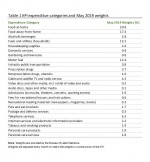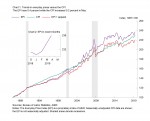Food and Energy Lift the AIER Everyday Price Index

AIER’s Everyday Price Index rose for the fourth consecutive month, posting a 0.4 percent gain in May versus a 0.2 percent gain in the Consumer Price Index. The EPI measures price changes people see in everyday purchases such as groceries, restaurant meals, gasoline, and utilities. The EPI is not seasonally adjusted, so we compare it with the unadjusted CPI. The EPI including apparel, a broader measure, gained 0.3 percent in May as apparel prices fell 0.9 percent for the month. Both measures exclude prices of infrequently purchased, big-ticket items (such as cars, appliances, and furniture) and prices contractually fixed for prolonged periods (such as housing).
Over the past 12 months, the EPI has risen 0.8 percent while the EPI including apparel is up 0.5 percent. The more widely known price gauge, the Consumer Price Index, reported by the Bureau of Labor Statistics, includes less frequently purchased items and everyday purchases. That measure is up 1.8 percent over the past 12 months. Over the last five years, the EPI is up at a 0.2 percent annualized rate, the same as the EPI including apparel, but well below the 1.5 percent pace for the CPI.
Food and energy prices were the key drivers of the gain in the EPI in May. The two major components of food prices, food at home (groceries) and food away from home (primarily restaurants), rose 0.1 percent and 0.2 percent in May, on a not-seasonally-adjusted basis. Over the last 12 months, grocery prices are up 1.2 percent while restaurant prices are up 2.9 percent; the five-year annualized gains were 0.2 percent and 2.7 percent, respectively.
Within the broad energy category, motor fuel prices rose for the fourth month in a row, increasing 2.4 percent in May after jumping 10.1 percent in April. Household fuels and utilities rose 0.3 percent for the month, reversing a 0.3 percent decline in April.
The other significant contributors for the month were intracity transportation, up 1.1 percent, recreational reading materials, up 0.9 percent, and nonprescription drugs, up 0.6 percent. On the downside, the CPI for domestic services fell 2.2 percent for the month while apparel prices fell 0.9 percent and admissions prices dropped 0.4 percent.
Over the past year, more than three-fourths of the categories that make up the EPI have posted higher prices, with 7 categories showing a rise of less than 2 percent and 11 showing gains greater than 2 percent. Six of the categories show price declines over the past year. Among the largest gainers and decliners over the past year, apparel prices are down 3.1 percent from a year ago and telephone-services prices are down 1.8 percent while postage and delivery services are up 5.5 percent, tobacco and smoking products are up 4.6 percent, recreational reading materials are up 3.7 percent, fees for lessons are up 3.2 percent, and restaurants are up 2.9 percent, the same gain as pets and pet products and admissions fees.
Among the components with the largest weights in the EPI, as already mentioned, food at home (20.8 percent weight) is up 1.2 percent from a year ago while food away from home (17.4 percent) is up 2.9 percent, household fuels and utilities (13.2 percent) are up 0.2 percent for the year, and motor fuel (12.4 percent) is down 0.2 percent since last May. Combined, they account for 63.8 percent of the EPI.







